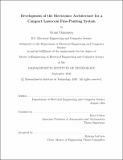| dc.contributor.advisor | Kerri Cahoy. | en_US |
| dc.contributor.author | Gunnison, Grant(Grant W.) | en_US |
| dc.contributor.other | Massachusetts Institute of Technology. Department of Electrical Engineering and Computer Science. | en_US |
| dc.date.accessioned | 2021-01-06T18:31:38Z | |
| dc.date.available | 2021-01-06T18:31:38Z | |
| dc.date.copyright | 2020 | en_US |
| dc.date.issued | 2020 | en_US |
| dc.identifier.uri | https://hdl.handle.net/1721.1/129151 | |
| dc.description | Thesis: M. Eng., Massachusetts Institute of Technology, Department of Electrical Engineering and Computer Science, September, 2020 | en_US |
| dc.description | Cataloged from student-submitted PDF of thesis. | en_US |
| dc.description | Includes bibliographical references (pages 87-90). | en_US |
| dc.description.abstract | CubeSats have become increasingly popular over the past two decades. Since their inception through a collaboration between Cal Poly and Stanford in 1999, CubeSats have allowed researchers and educators worldwide to develop their expertise in the design, assembly, integration and testing of small satellites. Since then, applications for CubeSats have extended beyond the academic and research community into industry and the military. CubeSats bring an unprecedented opportunity for remote sensing due to their relatively low-cost platforms and quick development time. By using Commercial-Off-The-Shelf (COTS) parts and adjusting the scope of their sensing capabilities, CubeSats can be deployed for a small fraction of the cost of traditional satellites. This has led to the development of a large number of CubeSats for applications including: communication systems, weather sensing, Earth imaging and surveillance. With space being more accessible than ever, the number of CubeSats in orbit has increased dramatically in recent years. With limited access to bandwidth and the growing demand for downlink capacity, engineering teams have looked for solutions beyond RF communication. An alternative communication architecture, laser communications (lasercom), is expected to improve performance, using advances in laser beam pointing and tracking technology. In this thesis we describe the electronics architecture for the Nanosatellite Optical Downlink Experiment (NODE) experiment. This architecture is built on the work of several graduate students and is expected to fly on CLICK-A in late 2020 or early 2021. We present the development of a viable integrated electronics implementation and subsystem laboratory verification for a 1.4U transmit-only CubeSat payload, NODE. NODE will be used to demonstrate downlink capability as part of the CubeSat Laser Infrared Crosslink Mission (CLICK)-A research project sponsored by the NASA Science Mission Directorate (NASA SMD). | en_US |
| dc.description.statementofresponsibility | by Grant Gunnison. | en_US |
| dc.format.extent | 90 pages | en_US |
| dc.language.iso | eng | en_US |
| dc.publisher | Massachusetts Institute of Technology | en_US |
| dc.rights | MIT theses may be protected by copyright. Please reuse MIT thesis content according to the MIT Libraries Permissions Policy, which is available through the URL provided. | en_US |
| dc.rights.uri | http://dspace.mit.edu/handle/1721.1/7582 | en_US |
| dc.subject | Electrical Engineering and Computer Science. | en_US |
| dc.title | Development of the electronics architecture for a compact lasercom fine-pointing system | en_US |
| dc.type | Thesis | en_US |
| dc.description.degree | M. Eng. | en_US |
| dc.contributor.department | Massachusetts Institute of Technology. Department of Electrical Engineering and Computer Science | en_US |
| dc.identifier.oclc | 1227275469 | en_US |
| dc.description.collection | M.Eng. Massachusetts Institute of Technology, Department of Electrical Engineering and Computer Science | en_US |
| dspace.imported | 2021-01-06T18:31:37Z | en_US |
| mit.thesis.degree | Master | en_US |
| mit.thesis.department | EECS | en_US |
